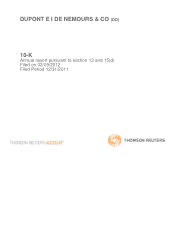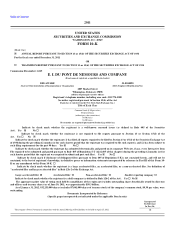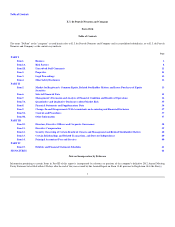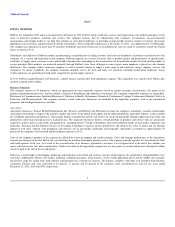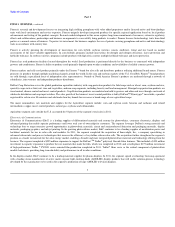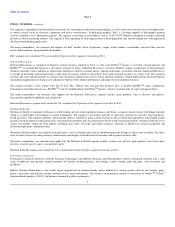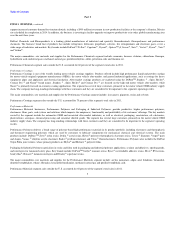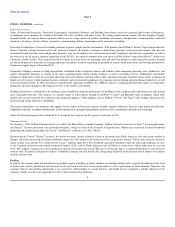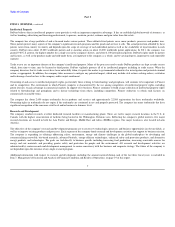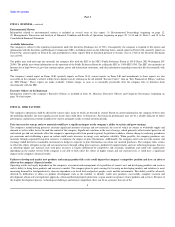DuPont 2011 Annual Report Download - page 11
Download and view the complete annual report
Please find page 11 of the 2011 DuPont annual report below. You can navigate through the pages in the report by either clicking on the pages listed below, or by using the keyword search tool below to find specific information within the annual report.
Table of Contents
Part I
ITEM 1. BUSINESS, continued
Environmental Matters
Information related to environmental matters is included in several areas of this report: (1) Environmental Proceedings beginning on page 12,
(2) Management's Discussion and Analysis of Financial Condition and Results of Operations beginning on pages 29, 33-34 and (3) Notes 1 and 15 to the
Consolidated Financial Statements.
Available Information
The company is subject to the reporting requirements under the Securities Exchange Act of 1934. Consequently, the company is required to file reports and
information with the Securities and Exchange Commission (SEC), including reports on the following forms: annual report on Form 10-K, quarterly reports on
Form 10-Q, current reports on Form 8-K, and amendments to those reports filed or furnished pursuant to Section 13(a) or 15(d) of the Securities Exchange
Act of 1934.
The public may read and copy any materials the company files with the SEC at the SEC's Public Reference Room at 100 F Street, NE, Washington, DC
20549. The public may obtain information on the operation of the Public Reference Room by calling the SEC at 1-800-SEC-0330. The SEC also maintains an
Internet site at http://www.sec.gov that contains reports, proxy and information statements, and other information regarding issuers that file electronically with
the SEC.
The company's annual report on Form 10-K, quarterly reports on Form 10-Q, current reports on Form 8-K and amendments to those reports are also
accessible on the company's website at http://www.dupont.com by clicking on the tab labeled "Investor Center", then on "Key Financials & Filings" and then
on "SEC Filings." These reports are made available, without charge, as soon as is reasonably practicable after the company files or furnishes them
electronically with the SEC.
Executive Officers of the Registrant
Information related to the company's Executive Officers is included in Item 10, Directors, Executive Officers and Corporate Governance, beginning on
page 38 of this report.
ITEM 1A. RISK FACTORS
The company's operations could be affected by various risks, many of which are beyond its control. Based on current information, the company believes that
the following identifies the most significant risk factors that could affect its businesses. Past financial performance may not be a reliable indicator of future
performance and historical trends should not be used to anticipate results or trends in future periods.
Price increases for energy and raw materials could have a significant impact on the company's ability to sustain and grow earnings.
The company's manufacturing processes consume significant amounts of energy and raw materials, the costs of which are subject to worldwide supply and
demand as well as other factors beyond the control of the company. Significant variations in the cost of energy, which primarily reflect market prices for oil
and natural gas and raw materials affect the company's operating results from period to period. Legislation to address climate change by reducing greenhouse
gas emissions and establishing a price on carbon could create increases in energy costs and price volatility. When possible, the company purchases raw
materials through negotiated long-term contracts to minimize the impact of price fluctuations. Additionally, the company enters into over-the-counter and
exchange traded derivative commodity instruments to hedge its exposure to price fluctuations on certain raw material purchases. The company takes actions
to offset the effects of higher energy and raw material costs through selling price increases, productivity improvements and cost reduction programs. Success
in offsetting higher raw material costs with price increases is largely influenced by competitive and economic conditions and could vary significantly
depending on the market served. If the company is not able to fully offset the effects of higher energy and raw material costs, it could have a significant
impact on the company's financial results.
Failure to develop and market new products and manage product life cycles could impact the company's competitive position and have an adverse
effect on the company's financial results.
Operating results are largely dependent on the company's assessment and management of its portfolio of current, new and developing products and services
and its ability to bring those products and services to market. The company plans to grow earnings by focusing on developing markets and solutions to meet
increasing demand for food productivity, decrease dependency on fossil fuels and protect people, assets and the environment. This ability could be adversely
affected by difficulties or delays in product development such as the inability to identify viable new products, successfully complete research and
development, obtain relevant regulatory approvals, obtain intellectual property protection, or gain market acceptance of new products and services. Because of
the lengthy development process, technological challenges and intense competition, there can be no assurance that any of the
8

